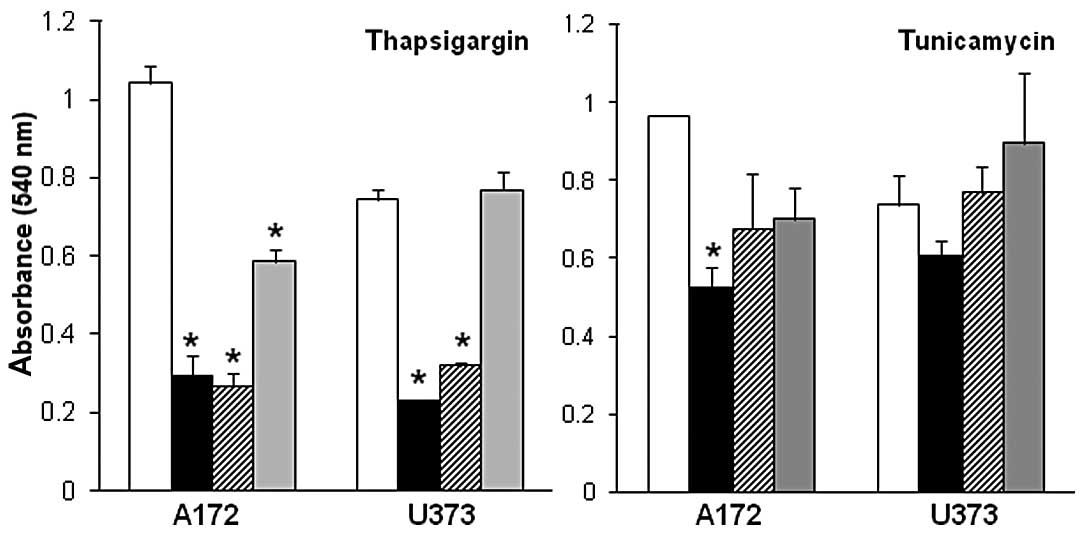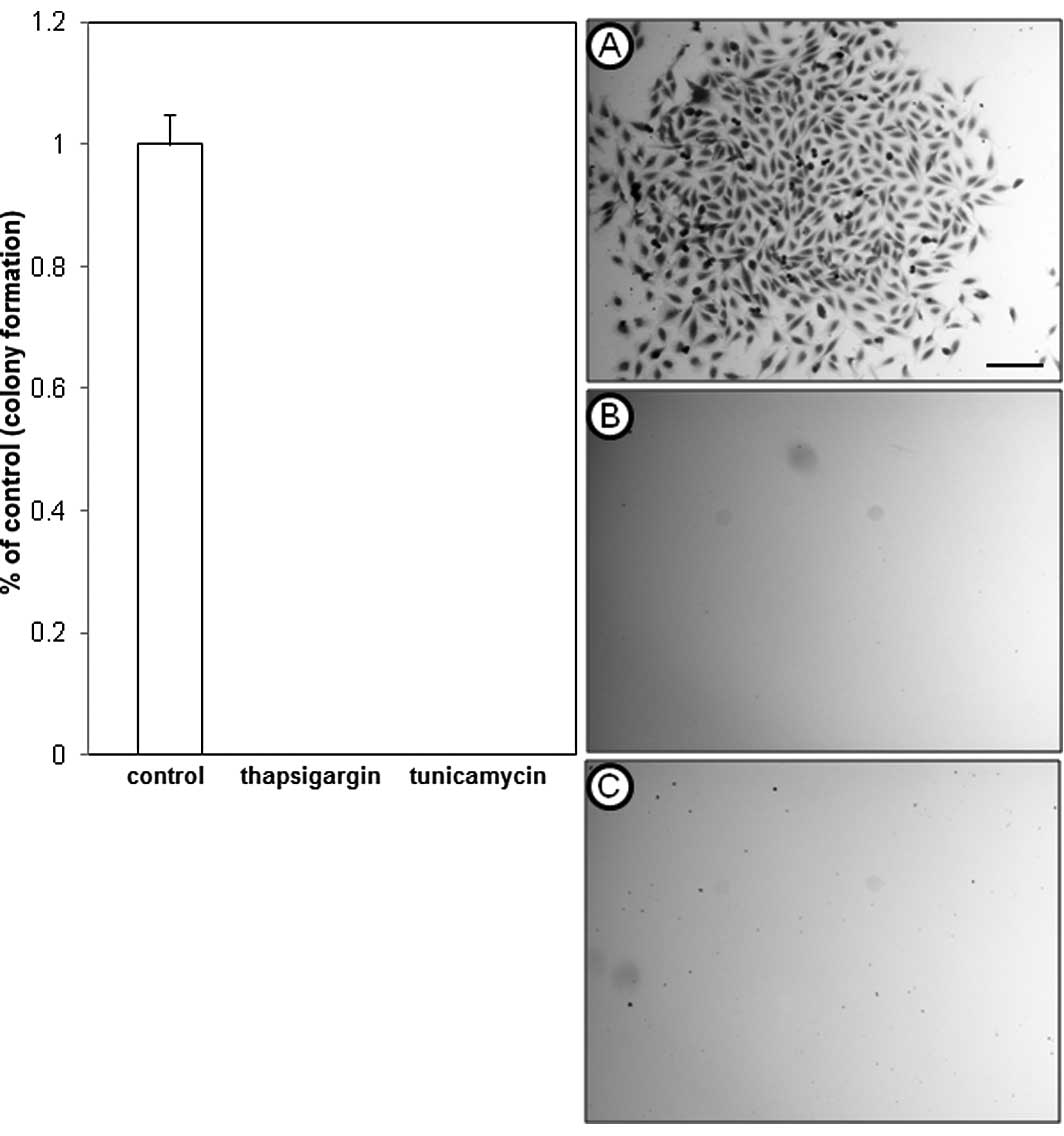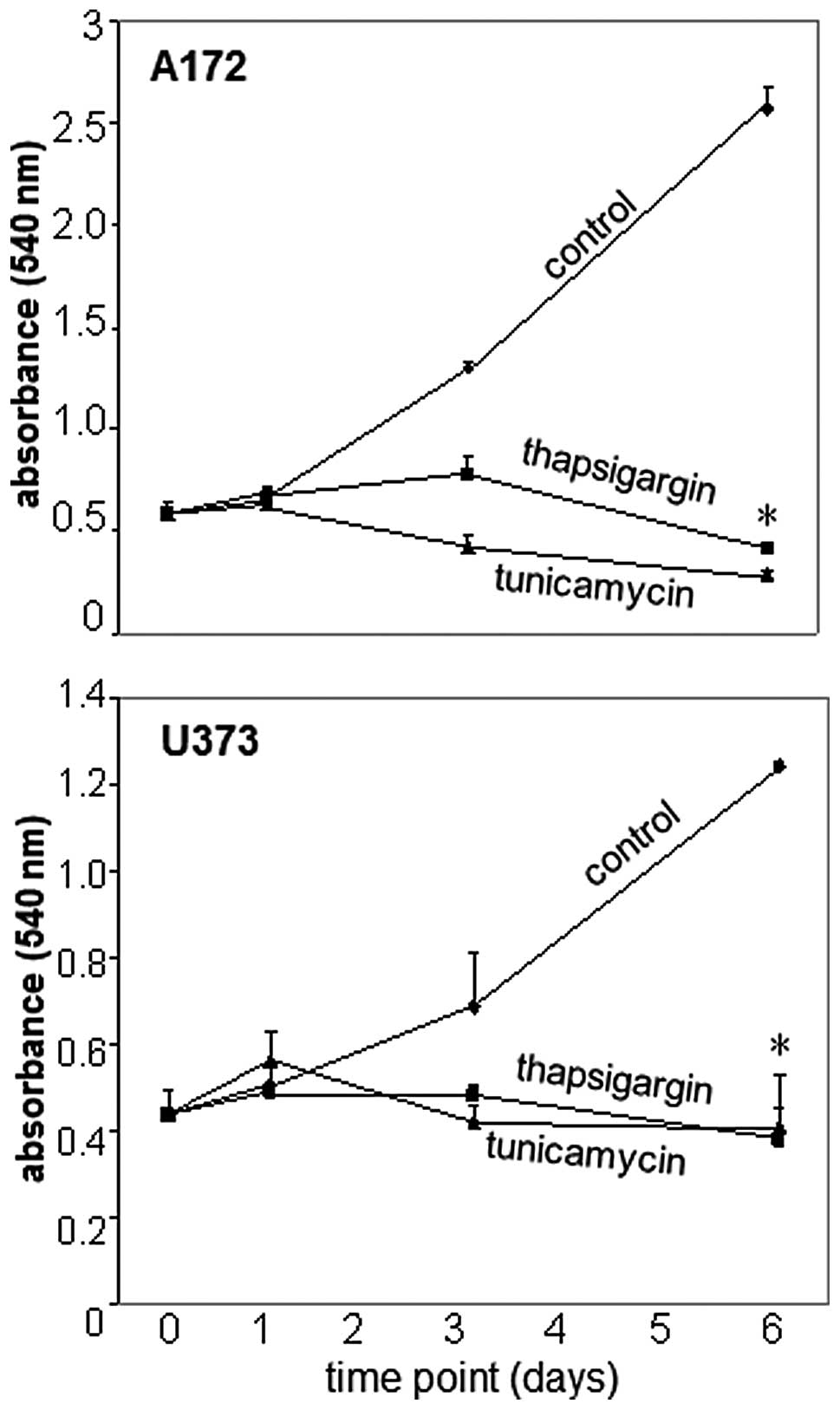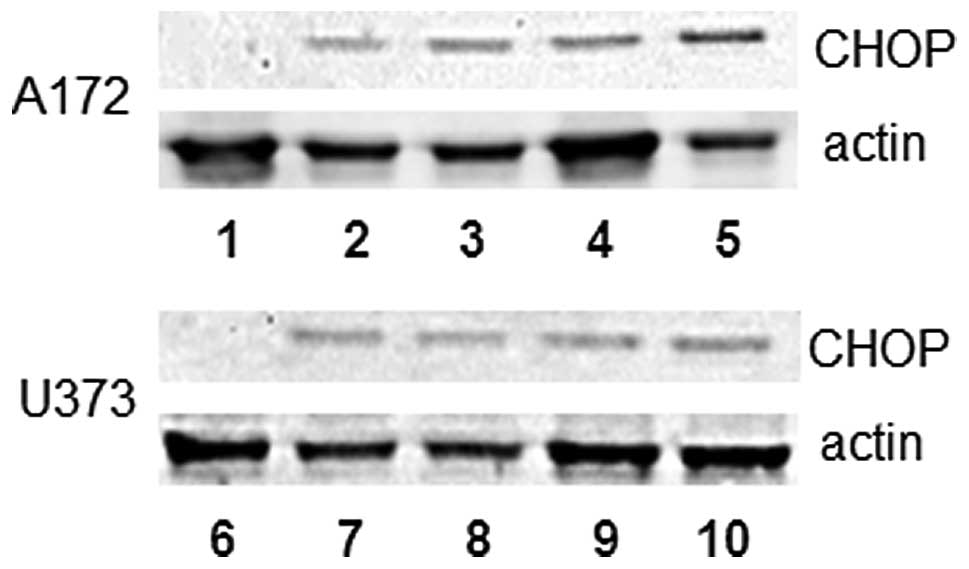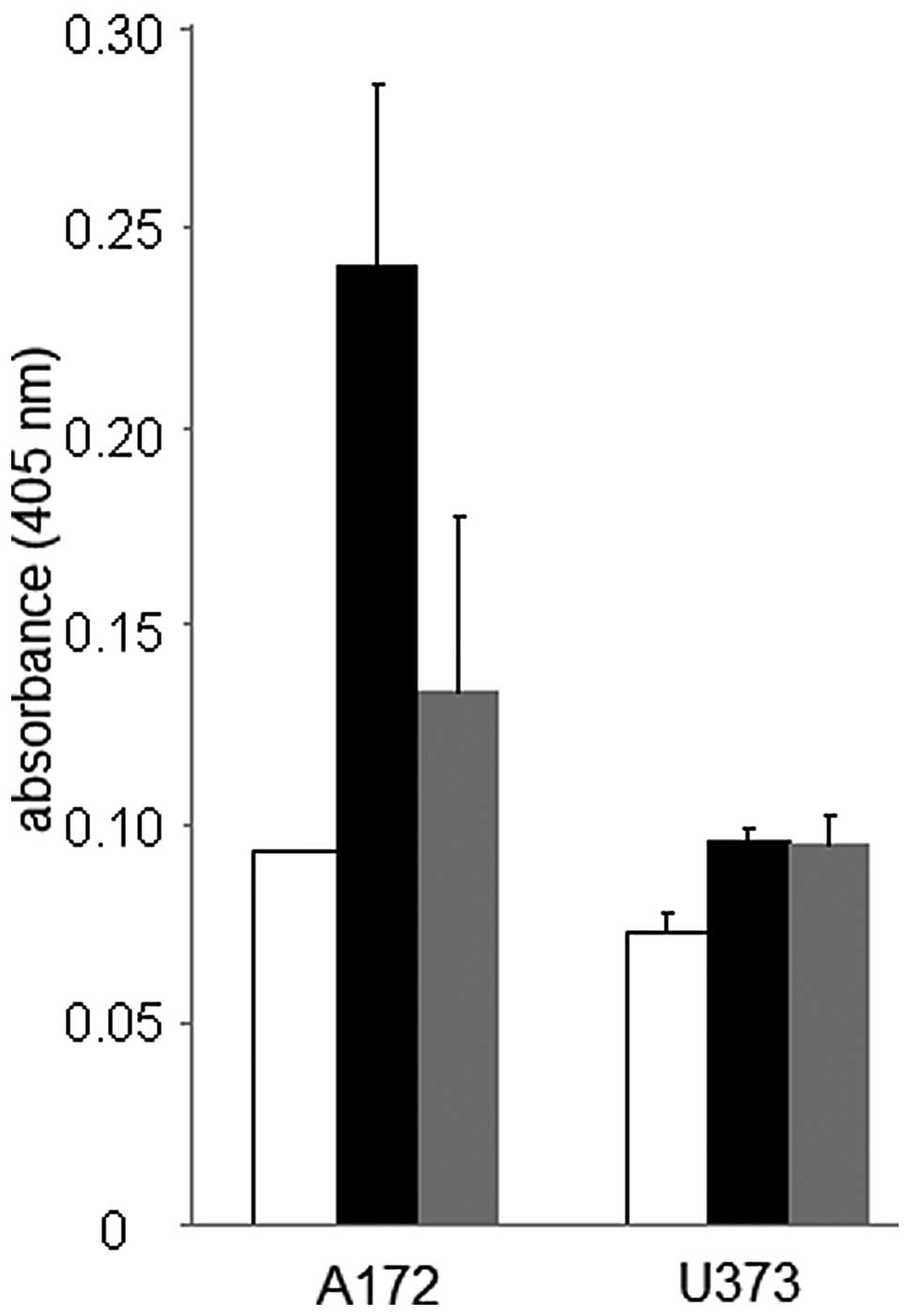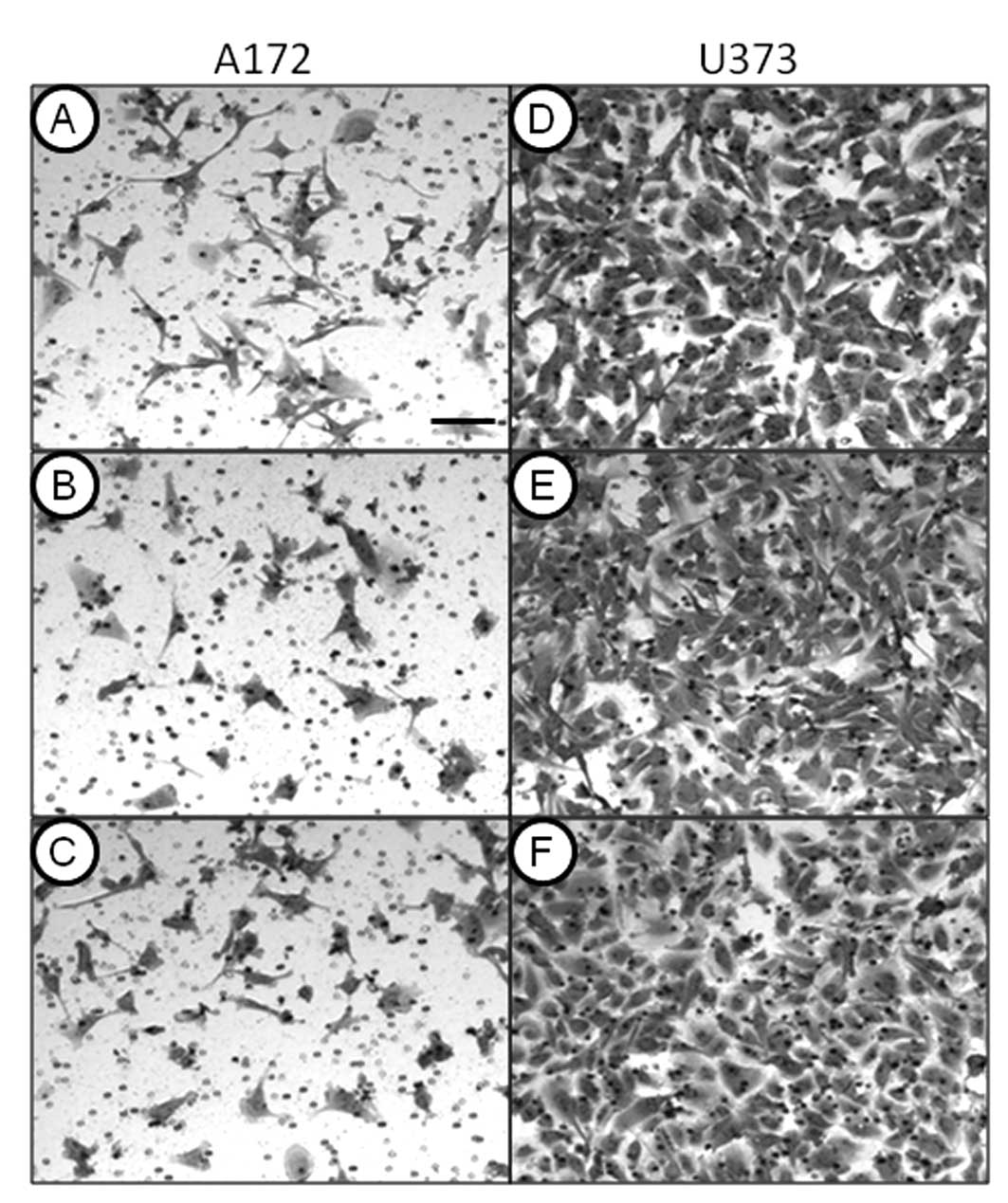CHOP and caspase 3 induction underlie glioblastoma cell death in response to endoplasmic reticulum stress
- Authors:
- Published online on: December 19, 2011 https://doi.org/10.3892/etm.2011.422
- Pages: 487-492
Abstract
Introduction
Glioblastomas are among the most chemo-resistant types of human cancers to treat clinically. The refractiveness of glioblastomas to chemotherapy treatment regimens may be attributed in part to the activation of a number of cytoprotective mechanisms in response to chemotherapeutic agents (1,2). One such cytoprotective mechanism that has emerged and received considerable attention as a contributing factor to the therapeutic resistance of a number of types of human cancer in general, and in glioblastomas in particular, is the unfolded protein endoplasmic reticulum stress response (3,4). The unfolded protein endoplasmic reticulum stress response fundamentally functions as an adaptive cellular program essential for normal cellular function and survival, that is triggered by the accumulation of unfolded proteins in the endoplasmic reticulum due to a number of stress inducers, such as hypoxia, oxidative injury, glucose deprivation and aberrant calcium levels. However, if the stress applied to the endoplasmic reticulum is excessive and exceeds its ability to maintain homeostatic control, apoptotic cell death ensues (3,4). Therefore, assessing the efficacy of agents that invoke endoplasmic reticulum stress for their utility as potential chemotherapeutic drugs that promote glioblastoma cell death should be given practical consideration. In support of this, a number of investigational studies have demonstrated the anti-tumorigenic effects of novel endoplasmic reticulum stress inducers in leukemia (5), stomach (6) and prostate cancer (7). Furthermore, recent studies have established that glucose regulated protein 78 (GRP78), an endoplasmic reticulum chaperone with anti-apoptotic properties and a significant role in the unfolded protein endoplasmic reticulum stress response signaling pathway, is overexpressed in malignant gliomas (8–10).
To this end, in the present study, we examined two endoplasmic reticulum stress inducers, thapsigargin and tunicamycin, for their anti-tumor properties on glioblastomas. Thapsigargin, an active component found in root extracts of the umbelliferous plant, Thapsia garganica, acts as a stress inducer by increasing the intracellular calcium concentration via the inhibition of calcium uptake into the endoplasmic reticulum by blocking its ATP-dependent calcium pump (11), while tunicamycin, a nucleoside antibiotic produced by several Streptomyces species, imposes cellular stress by inhibiting protein N-linked glycosylation, the first step in protein glycosylation (12). This study reveals that the endoplasmic reticulum stress inducers, thapsigargin and tunicamycin, promote glioblastoma cell death as a consequence of inducing the pro-apoptotic proteins, C/EBP homologous protein (CHOP) and caspase 3.
Materials and methods
Cells, conditions and reagents
U373 and A172 glioblastoma cells were purchased from the American Type Culture Collection (Manassas, VA, USA). All cell lines were maintained in Dulbecco's modified Eagle's medium (DMEM) (Invitrogen, Carlsbad, CA, USA) containing 10% fetal bovine serum (Invitrogen), 2 mM L-glutamine (Invitrogen), 100 nM MEM non-essential amino acids (Invitrogen) and penicillin-streptomycin (Invitrogen) at 37°C and 5% CO2. Thapsigargin and tunicamycin were purchased from Tocris (Ellisville, MO, USA).
Crystal violet cell proliferation assay
Dose response
Cells were plated in 12-well plates, treated with 1, 5 and 10 μM thapsigargin or tunicamycin and allowed to incubate for 48 h [vehicle controls were treated with dimethyl sulfoxide (DMSO)]. The tissue culture medium was then removed, and the cell monolayer was fixed with 100% methanol for 5 min and stained with 0.5% crystal violet in 25% methanol for 10 min. The cells were then washed three times for 5 min each with distilled water to remove excess dye and allowed to dry overnight at room temperature. The incorporated dye was then solubilized in 0.1 M sodium citrate (Sigma-Aldrich, St. Louis, MO, USA) in 50% ethanol. Subsequently, 100 μl of treated and control samples were transferred to 96-well plates and optical densities were read at 540 nm using an X-mark microplate absorbance spectrophotometer (BioRad, Hercules, CA, USA).
Time course analysis. Cells were plated in 96-well plates for 24 h, treated with 1 μM thapsigargin or tunicamycin and allowed to incubate for 1, 3 and 6 days at 37°C. At the end of each time-point the cells were stained with crystal violet, solubilized with sodium citrate, and the optical densities were read as described above.
Clonogenic survival
Cells were plated for 24 h, treated with 1 μM and 250 nM thapsigargin, tunicamycin or DMSO (vehicle) and allowed to incubate at 37°C for 10–14 days. At the termination of the incubation period, cells were fixed with absolute methanol, stained with 1% crystal violet for 10 min, rinsed in tap water and allowed to dry. Colonies, consisting of ≥50 cells, were then counted to determine the surviving fraction.
Cell motility
Motility assays were conducted according to the manufacturer's instructions (Cell Biolabs Inc., San Diego, CA, USA). A cell suspension containing 0.5–1.0×106 cells/ ml was prepared in serum-free medium with the vehicle (DMSO), 1 μM thapsigargin or 1 μM tunicamycin, while 500 μl of medium containing 10% fetal bovine serum were added to the lower chamber of the migration plate. A total of 300 μl of cell suspension containing vehicle, 1 μM thapsigargin or tunicamycin was then added to the inside of each insert and allowed to incubate for 24 h at 37°C and 5% CO2. Subsequently, non-migratory cells were removed from plate inserts (according to the manufacturer's instructions) and migratory cells were counterstained with cell staining solution (Cell Biolabs Inc.).
Western blotting
Cells were plated in serum-free DMEM for 24 h, treated with 1 μM thapsigargin, 1 μM tunicamycin or the vehicle, and allowed to incubate for 24 and 48 h. The cells were then lysed in lysis buffer (pH 6.8) containing 60 mM Tris and 2% SDS. Protein concentrations were determined using the Bradford method. Subsequently, protein samples were electrophoresed in a 4–12% Tris-HCl polyacrylamide gel, transferred to nitrocellulose membranes and immunoblotted with antibodies against CHOP (Cell Signaling, Danvers, MA, USA). Protein levels were detected using a horseradish peroxidase conjugated secondary antibody and the chemiluminescence detection system (Pierce, Rockford, IL, USA).
Detection of caspase activity
Cells were plated in serum-free DMEM for 24 h, treated with 1 μM thapsigargin, 1 μM tunicamycin or the vehicle and allowed to incubate for 48 h. Cells were lysed in lysis buffer (pH 6.8) containing 60 mM Tris and 2% SDS, and protein concentrations were determined using the Bradford method. Subsequently, caspase 3 activity assays were conducted according to manufacturer's instructions using 30 μg of protein (Promega, Madison, WI, USA).
Results
Endoplasmic reticulum stress inducers impede glioblastoma cell production
Eliciting a hyper-stress response in the endoplasmic reticulum as a means of promoting anti-tumor cell behavior due to the accumulation of unfolded proteins or an unstable physiological cellular environment, such as increased intracellular calcium concentration, has been demonstrated in a variety of types of human cancer (13–17). In this study, we performed a comparative assessment of two endoplasmic reticulum stress inducers, thapsigargin and tunicamycin, with markedly different modes of stressing the endoplasmic reticulum for their anti-tumor properties on glioblastomas. Thapsigargin and tunicamycin were first examined for their effects on glioblastoma cells in dose-response experiments. These experiments revealed a dose-dependent decrease in glioblastoma cell proliferation in A172 and U373 cells exposed to increasing concentrations (1–10 μM) of thapsigargin or tunicamycin, as compared to the vehicle-treated control cells (Fig. 1). Dose response data also revealed that the inhibitory effects on A172 and U373 glioblastoma cell proliferation were more pronounced in the cells treated with 5–10 μM thapsigargin as compared to the cells treated with 5–10 μM tunicamycin. Additionally, A172 cells appeared to be more sensitive to endoplasmic reticulum stress as indicated by a 44±6 and 27±11% reduction in cell proliferation (compared to controls) when treated with 1 μM thapsigargin or tunicamycin, respectively, in comparison to the U373 cells treated with either endoplasmic reticulum stress inducer at the same concentration.
To further examine the inhibitory effects of thapsigargin and tunicamycin on glioblastoma cell production, clonogenic survival assays that measure cellular reproductive capacity at low cell plating densities were performed by treating A172 and U373 cells with 1 μM thapsigargin or tunicamycin. This concentration was selected for its non-lethal effects on U373 cells, and showed an inhibitory concentration greater than 50 (>IC50) in A172 cells, as shown in the dose-response experiments. Clonogenic survival experiments revealed that in comparison to the vehicle-treated control cells, thapsigargin or tunicamycin completely abrogated colony formation of A172 (Fig. 2) and U373 (Fig. 3) cells.
In addition to clonogenic survival experiments, time-course experiments were performed as a means to determine the cellular behavior underlying the inhibition of glioblastoma cell proliferation in response to thapsigargin or tunicamycin exposure (Fig. 4). Analysis of glioblastoma cell proliferation was conducted over a 6-day period post-exposure to the vehicle, thapsigargin or tunicamycin. The most demonstrative effects of thapsigargin or tunicamycin on A172 and U373 cell production were observed on day 6, with a statistically significant (p<0.05) decrease in glioblastoma cell proliferation as compared to the vehicle-treated control cells examined at the same time-point (Fig. 4). Time course data also displayed a 28±4 and 52±4% reduction in A172 cell proliferation 6 days post-treatment with thapsigargin or tunicamycin, respectively, in comparison to A172 cell proliferation observed on day 0 (Fig. 4). A comparative assessment between these same time-points in U373 cells also revealed a decrease in cell proliferation 6 days post-treatment with either thapsigargin or tunicamycin when compared to U373 cell proliferation on day 0 (Fig. 4). Taken together, the time course data presented here suggest that the overall inhibitory effect of thapsigargin and tunicamycin was due to glioblastoma cell death. These results are similar to those from other studies on several types of human cancer that also demonstrated that thapsigargin (18–21) and tunicamycin (22–24) promoted tumor cell death.
ER stress inducers increase CHOP expression and caspase 3 activity
It is well established that the inability of the endoplasmic reticulum to activate compensatory mechanisms essential for cellular survival in response to stress will subsequently lead to apoptotic cell death (3,4). CHOP, a basic-leucine zipper (bZIP) transcription factor, and caspase 3, a cysteine protease, are pro-apoptotic proteins known to play prominent roles in endoplasmic reticulum stress-induced cell death (25,26). We therefore evaluated the protein expression levels of CHOP and caspase 3 in thapsigargin- and tunicamycin-treated glioblastoma cells. A temporal analysis using immunoblotting procedures revealed an up-regulation of CHOP protein levels at 24 and 48 h in A172 and U373 cells treated with 1 μM thapsigargin or tunicamycin (Fig. 5). Caspase 3 activity assessment displayed a 2.6- and 1.43-fold increase in caspase 3 activity at 48 h in A172 cells treated with thapsigargin or tunicamycin, respectively, while a 1.32- and 1.30-fold increase in caspase 3 activity was observed at the same time-point in U373 cells treated with thapsigargin or tunicamycin (Fig. 6). Although our observations are consistent with previous ones on colon cancer, leukemia and neuroblastomas, which also demonstrated that thapsigargin or tunicamycin invoked CHOP expression or caspase 3 activity (24,27–30), few studies have shown the induction of both of these pro-apoptotic proteins in the same tumor type in response to single exposures of endoplasmic reticulum stress inducers with different modes of action. This suggests that glioblastomas are susceptible to endoplasmic reticulum stress-induced cell death by diverse physiological stressors.
Effects of ER stress on glioblastoma cell motility
Glioblastomas are notoriously invasive tumors with high rates of recurrence, which are major factors contributing to their therapeutic refractiveness during clinical treatment (surgery, chemo- and radiotherapy) regimens. Few studies to date have investigated the role of the unfolded protein endoplasmic reticulum stress response in tumor cell motility and invasion. However, a study by Chiu et al (31) on head and neck cancers revealed that silencing the function of the endoplasmic reticulum chaperone protein, GRP78, using siRNA reduced the metastatic potential of these cancers; thus, providing evidence for a role of the unfolded protein endoplasmic reticulum stress response in the metastatic invasion of tumor cells. Therefore, in this study, we examined the effects of thapsigargin and tunicamycin on glioblastoma cell motility, a prerequisite cellular program for invasive tumor cells. In contrast to the findings by Chiu et al (31), we did not observe antagonistic effects of thapsigargin or tunicamycin on glioblastoma cell motility (Fig. 7), which is likely due to variations in the experimental approach and the differential mechanisms targeted.
Discussion
Targeting the unfolded protein endoplasmic reticulum stress response is a relatively avant-garde yet practical therapeutic approach for the treatment of human cancers. Human tumors and their microenvironment are in a continuous flux of imbalance due to the presence of abnormally folded proteins and physiological instability, relating to fluctuations in pH and ion concentration, all of which invoke stress on tumor cells. As a survival mechanism, tumor cells respond via the activation of stress responders, such as GRP78/binding immunoglobulin protein (BiP), inositol-requiring enzyme 1α (IRE1α), protein kinase RNA-like endoplasmic reticulum kinase (PERK) and activating transcription factor 6 (ATF6) that collectively underlie the unfolded protein endoplasmic reticulum stress response and confer tumor cell cytoprotection (3,4). The involvement of cytoprotective stress responders in glioblastomas has been demonstrated in a number of recent investigations that together establish that high levels of GRP78 expression correlate with increased survival and drug resistance (8–10) in these tumors. However, studies to date have failed to demonstrate that antagonizing stress responder function, particularly GRP78, promotes glioblastoma cell death.
The dichotomy of the unfolded protein endoplasmic reticulum stress response is that stress exceeding the endoplasmic reticulum's capacity to promote cell survival will consequently result in cell death. To this end, in this study, we demonstrate that two endoplasmic reticulum stress inducers, thapsigargin and tunicamycin, promote glioblastoma cell death. Our findings are consistent with those from previous studies on several human cancers that also showed that thapsigargin (prostate, breast, leukemia, and melanoma) (18–20,30,32) and tunicamycin (neuroblastoma and melanoma) induced tumor cell death (24,33).
It is well established that the mechanism affiliated with endoplasmic reticulum stress-induced cell death is the activation of the transcription factor, CHOP, a downstream pro-apoptotic component of the IRE1α, PERK and ATF6 stress responder pathways (25). Concomitantly with glioblastoma cell death, we observed a significant increase in CHOP expression in response to endoplasmic recticulum stress inducers. These findings parallel those observed by Rosati et al (22) and Oda et al (24) who also detected increased CHOP expression levels in leukemia and neuroblastoma cells, respectively, in response to thapsigargin and tunicamycin. Although effector molecules of CHOP still remain somewhat elusive, its overexpression has been shown to lead to a decrease in the pro-survival protein, Bcl-2 (34), providing evidence that the pro-apoptotic functions of CHOP are associated with mitochondria-dependent mechanisms of cell death. Our data support this premise and were substantiated by observations of increased caspase 3 activity in glioblastoma cells treated with thapsigargin or tunicamycin.
In spite of the pro-apoptotic effects of endoplasmic reticulum stress inducers on glioblastoma cell production observed in this study, thapsigargin and tunicamycin failed to impair glioblastoma cell motility. This is in contrast to experimental data by Chiu et al who demonstrated that silencing GRP78 function reduced cell motility and prevented tumor cell invasion of head and neck cancers (31). The differential cell motility responses observed in this study and by Chiu et al are likely attributed to divergent cellular and physiological mechanisms targeted in the unfolded protein endoplasmic reticulum stress response between our two studies, and further emphasizes the pleiotropic effects of the endoplasmic reticulum stress response on cell behavior.
Taken together, we provided evidence that hyper-stressing the endoplasmic reticulum, by using endoplasmic reticulum stress inducers with markedly different modes of action, is a viable approach for the promotion of killing glioblastomas. Furthermore, our study suggests that endoplasmic reticulum stress inducers exert their anti-tumorigenic effects on proliferating cells, a selective advantage for treating clinical glioblastomas which typically reside in regions of the human brain that contain dormant cells.
Acknowledgements
This work was supported by grant number P20MD002731 from the National Institute on Minority Health and Health Disparities (MOF). The content is solely the responsibility of the authors and does not necessarily represent the official views of the National Institute on Minority Health and Health Disparities or the National Institutes of Health.



